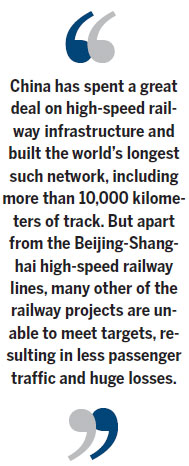High-speed rail not ideal stimulus vehicle
Updated: 2014-07-18 08:25
By Zhao Jian (China Daily Europe)
|
|||||||||||
Solving freight congestion is surely a more urgent need than building faster tracks
China's high-speed railway spending, as a part of recent limited stimulus measures, has been an important lever to help keep economic growth steady amid downward pressures. But despite reasonable arguments in favor of high-speed trains, it is not the answer to achieve another economic miracle, nor is it the right way to address the mismanagement of railways.
While other countries are debating the pros and cons of high-speed rail construction, it has already become a reality in China.
Beijing has announced a series of stimulus packages of high-speed rail building as the manufacturing sector has stagnated and export data has proved lackluster.
Chinese Vice-Premier Ma Kai said in April during a symposium on speeding up railway construction that the country would raise its spending targets on railway infrastructure to 800 billion yuan ($128 billion) in 2014. It is the third time the target has been increased from the original goal of 630 billion yuan. At the same time, the number of new projects is rising from 44 to 64.
This year, 12 railway lines with a length of more than 5,000 kilometers will be put into operation, according to a report on the development of China's high-speed rail industry released by the State Railway Administration. Meanwhile, local governments are also racing for the approval of further high-speed rail projects.

With a total investment of $8.37 billion, Shandong province got the first green light, to build a Jinan-Qingdao high-speed railway line starting in 2015. It is expected to be completed in 42 months.
The driving force behind such large-scale high-speed railway construction promoted by local governments is to boost local economic growth through low-risk investments in railways, especially when the transformation of development patterns and industrial restructuring has yet to be finished in these places.
China has spent a great deal on high-speed railway infrastructure and built the world's longest network, including more than 10,000 kilometers of track. But apart from the Beijing-Shanghai high-speed railway lines, many of the projects are unable to meet targets, resulting in less passenger traffic and huge losses.
It is unwise to approve so many high-speed rail projects as a way of managing the country's transportation network -the current capacity of railway freight does not match up with freight demand in some places where coal, steel and other commodities still rely on road transportation.
Under such circumstances, the high-speed rail plan is not going to deal with the problems of uneven management of its railways. Instead, the answer to such problems is to choose wisely when approving rail projects, picking those that can resolve cases of freight congestion rather than the high-speed rails.
China's high-speed railway system is already saddled with 3 trillion yuan of debt, but China Railway Corporation, the country's top railway operator, is unable to pay it back. That could create concerns, but it will be the government that will have to step in to fix things.
That doesn't mean that China should not expand its high-speed rail network. But the system should be developed in a cautious way with lots of planning.
Because mega-regions seem to be developing into a trend in the development of urban areas amid the country's urbanization plan, China needs to develop its urban rail transportation. That includes subways and commuter railroads, which will relieve some important problems experienced by high-density urban populations.
It is likely that around 20 mega-regions will evolve around mega-cities and major cities in different provinces. For example, the Capital Economic Zone encompasses Beijing and Tianjin; the Pearl River Delta region includes Guangzhou, Shenzhen and Hong Kong; and the Yangtze River Delta region is built around Shanghai.
Further development of underground tram systems and a high-speed commuter rail system will largely reduce transportation pressures in large cities, drive economic growth in the outskirts and curb housing prices.
Such high-speed services are meant to facilitate regional integration and development while providing urban public transportation.
Steady economic growth, however, should rely on deep reforms instead of limited stimulus packages.
The author is a professor at Beijing Jiaotong University.
(China Daily European Weekly 07/18/2014 page9)
Today's Top News
Burning wreckage, bodies scattered after jet downed
US widens sanctions on Russia over Ukraine
Hamas agrees on 5-hr ceasefire
Chinese killed in Moscow metro derailment
Obama vows info co-op to Merkel
Filipinos flee as typhoon hits coast
China ends drilling operations in South China Sea
Economic ties with Latin America grow
Hot Topics
Lunar probe , China growth forecasts, Emission rules get tougher, China seen through 'colored lens', International board,
Editor's Picks

|

|

|

|

|

|





